10: Redesigned Class Structure: Emphasizing Goals, Agency, and Reflection
Changes to how I'm ungrading.
Welcome to Field Reports!
Every two weeks, I share insights and updates from my classroom, reflecting on my pedagogical practices.
For creative writing and ELA activities to use in your class, check out Plug & Play!
I’m always tinkering because I am not yet satisfied with my class structure. Truthfully, I will never be satisfied because there is no stasis; education isn’t a sudoku puzzle. Every design creates affordances and barriers, and I’m often weighing them against research I read and needs I perceive. Although I’ve never ridden a unicycle, I imagine it to be similar: balance as an act of continual maintenance as opposed to cross-off-able achievement.
Over winter break, I tinkered a lot. So much so that it resulted in a large update to my class structure and ungrading system.
First, I’ll share my priorities in the design, then I’ll share the changes I’ve made.
Design Priorities:
Center my classroom on learning.
Emphasize goal setting, work, and reflection.
Have students forget about grades.
Help students embrace the stewardship of their own education.
Make English class a forum for “The Great Conversation.1”
The Changes
Goals
At the beginning of the school year, I had students set reading and writing goals every two weeks. These goals were peripheral to what we did as a class. This new semester, I’ve brought goals to the center of our focus.
I’m framing goals in terms of “inputs” and “outputs.” (What parts of the great conversation do we want to listen to? What parts do we want to contribute to?)
I’ve prescribed term goals for the whole class and had students set their own term goals. (Student goals can now include more media types: podcasts, discographies, video essays, etc.)
Once we’ve set term goals, we set mini-goals (every two weeks) to monitor our progress.
Here’s the general pattern of class time:
~15-20 minutes for students to silently and individually work on their mini-goals.
Gather as a class to work on our class mini-goals (the ones I’ve prescribed). This lasts around 30-40 minutes.
For the remainder of class, students work on their own goals, our class goals, or revise work from previous classes.
Here’s an example of the goal sheet for my English 11 class (each student fills one out and tapes it to the inside of their notebook):
The left side of the paper shows the goals for the term; the right side shows the mini-goals. Text in blue shows goals I’ve prescribed for the class; text in green shows ideas of what students might set as their own goals.
My juniors are engaging with the question, “What do we owe each other?” We’ll read Anthem by Ayn Rand to introduce us to one view on this topic. Then, we’ll read March by John Lewis and Andrew Aydin. I’m excited for my students to engage with these ideas and for them to compare/contrast a textual allegory (Anthem) with a personal narrative graphic novel (March). I’ve never juxtaposed these texts, so I’m excited to see what we learn!
Reflection
Every two weeks, I’ll have students reflect on the goals by writing a short (no more than 300-word) letter to me. I give them specific data/feedback to review, questions to answer, and ideas to consider. By reflecting, students realize where they’re at in relation to what they’re trying to accomplish. When I read the letters, I’ll gain a feel for how they’re doing individually and can provide one-on-one assistance.
At the start of the year, I intended to have brief, in-person conferences with each student every two weeks. I wasn’t able to follow through on these conferences. I lacked the discipline, structure, and time-management to make it happen. I’m hoping these letters will be more manageable. We’ll see!
Ungrading
There are no points in my class (this has been the case for a while). Instead, students do work, and I provide them with feedback of how they can improve. Last semester, I put a “P” or “W” in the gradebook for each assignment (P = passed-off; W = work on it).
Points typically move students’ brains away from learning the material and more towards calculating the minimum work they can do for the maximum amount of points. The P/W system helped redirect students toward the material because to get something “passed-off” they had to actually learn the thing.
Of course students still asked questions like “will this give me enough points?” but that question took the form of “is this passed-off?” In my opinion, the latter question is better because it was sandwiched by questions like, “is this part of my writing convincing?” or “I need help brainstorming ideas…” or “how can I make this clearer?” These are questions that help students engage with their work and learn.
So, what am I changing?
I found that the P/W system was unhelpful because, if a student received a W, they didn’t know how far away they were from passing something off. They had to go into the assignment and read through my feedback. Initially, this was a feature, not a bug: I wanted my students to dig back into the work.
Over the break, however, I decided to switch the P/W system to something more granular. Now students receive a 1-4 mark. (Standards-based grading often uses a 1-4 rubric/criteria chart; I am not doing this.) At a cursory glance, students better understand their proximity to the standards of an assignment. I still give feedback and coaching to each student. I’m hopeful that students won’t interpret the 1-4’s as points (I emphasized this), but only time will tell.
The 1-4 scale is also nice for when there are class trends. After reviewing all the work, I write one message that says: “If your work is marked with a 1, focus on x, y, z; if your work is marked with a 2, your task is… etc.”
The final change to my ungrading system will be to have grading conferences instead of grade proposals sheets. In the past, students would reflect on the term and propose a grade. I’d take the proposals home to read on my own time. If I had questions, I’d have to email students, but not every student would reply. This process became sticky and difficult.
In-person grading conferences will take more time, but I’m hopeful they will be better.
Writing Tasks
Each term I’ll have a set amount of low-stakes writing tasks for students to do. Near the end of the term, students will look through their portfolios (a combination of the writing tasks I prescribe and whatever writing they choose to do) and pick one piece to workshop.
On some writing tasks, students will choose the form but not the topic. Other times, I’ll prescribe the form, and they will choose the topic.
For the first writing task, I shared this video and then gave them these instructions:
Write something that communicates the idea of “being a mosaic of everyone you’ve ever loved.”
Consider who you want to read your writing.
Consider your medium/genre: poetry, video, fiction, essay.
Write a proposal to me of what you think you want to do.
Once I’ve reviewed your proposal, begin making the thing.
Authentic writing happens when an individual has something to say to a certain group of people. It’s hard to foster this systematically in a diverse class, but I think these writing tasks might be a step in the right direction.
A Tip When Implementing Structural Change
I spent a lot of time thinking through these changes which resulted in, what felt like, a ✨grand vision✨. I thought that in order for my students to understand and be on board for the changes, they’d need to understand the vision as well. I made a slide show and revised it a bunch after getting feedback from teachers/parents.
It didn’t go terribly, but it didn’t go as well as I would have hoped. The good was overshadowed by more confusion than I anticipated. All things considered, I wish I would have only told them what they needed to know to feel excited and start working. I could have filled in the additional steps/aspects of the structure as we went along the term.
This screenshot of student responses is representative of the overall reaction (a mix of excitement and confusion, garnished with indifference 😂).
I asked them, “What are your thoughts/feelings on the new class structure?”
Just for Fun
The pages of my notebook as I was thinking through these changes:
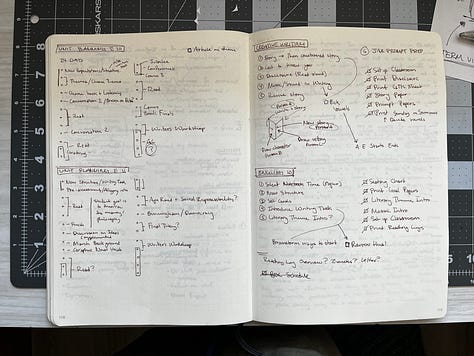
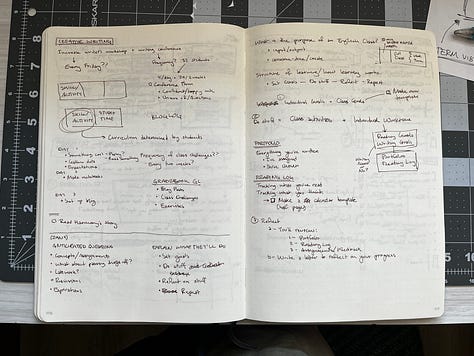
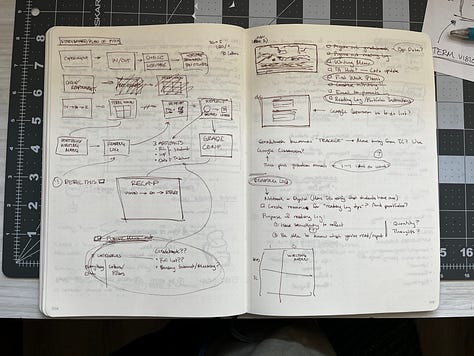
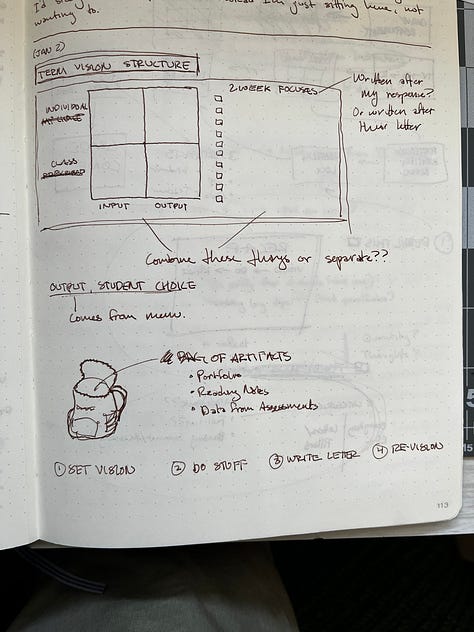
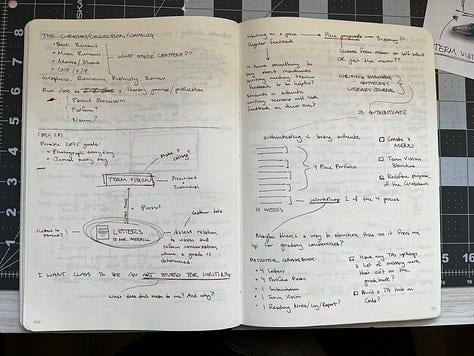
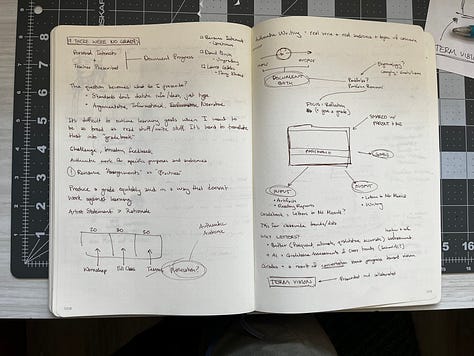
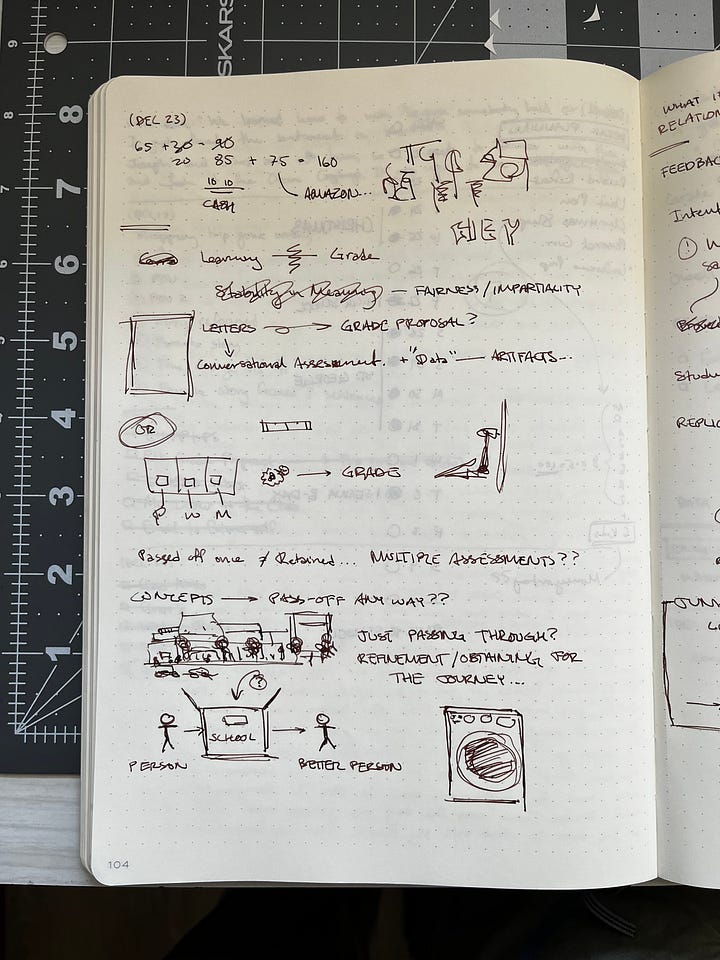
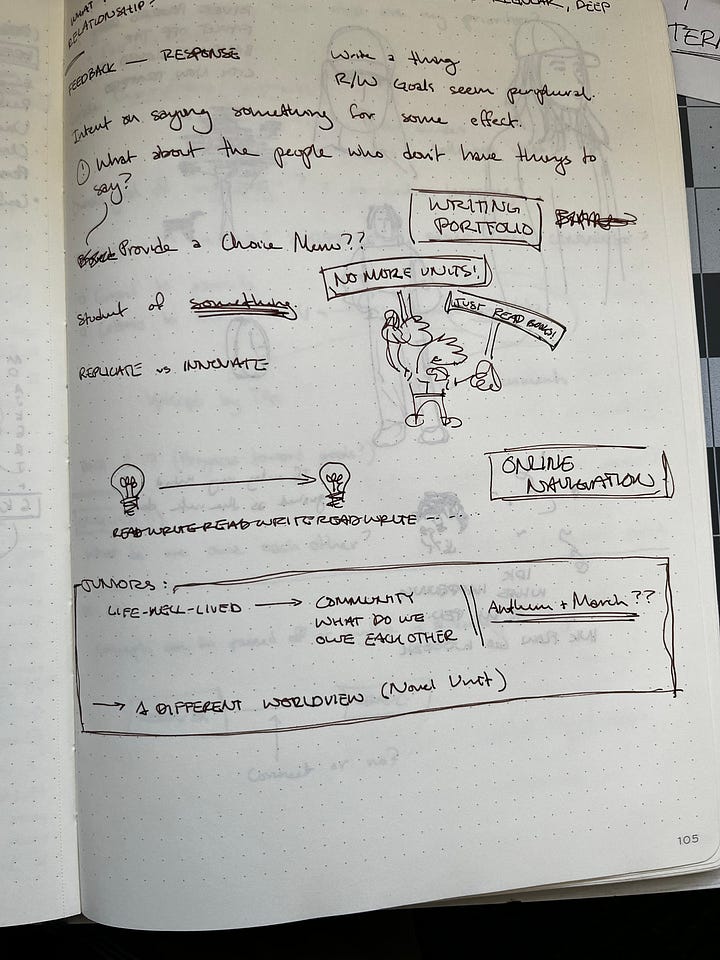
Thank you for reading!! If you have insights to share related to the topics I’ve discussed, I’d love to hear from you.
📼 My collection of videos to start class.
🖋️ Poems I share with my students.
🎹 My playlist of gentle music.
📚 What I’m reading/highlighting.
Footnotes
“The Great Conversation” is the idea that humans across time and place have all engaged in big questions about life. Love, meaning, grief, greed, time, patience, beauty, etc. are all topics of this conversation. Movies, music, art, and literature is how this conversation takes place.
English class is about participating in “The Great Conversation.” We eavesdrop across centuries. We listen and chime in.
In less romanticized language (and maybe more economic): English class is about learning to communicate.









